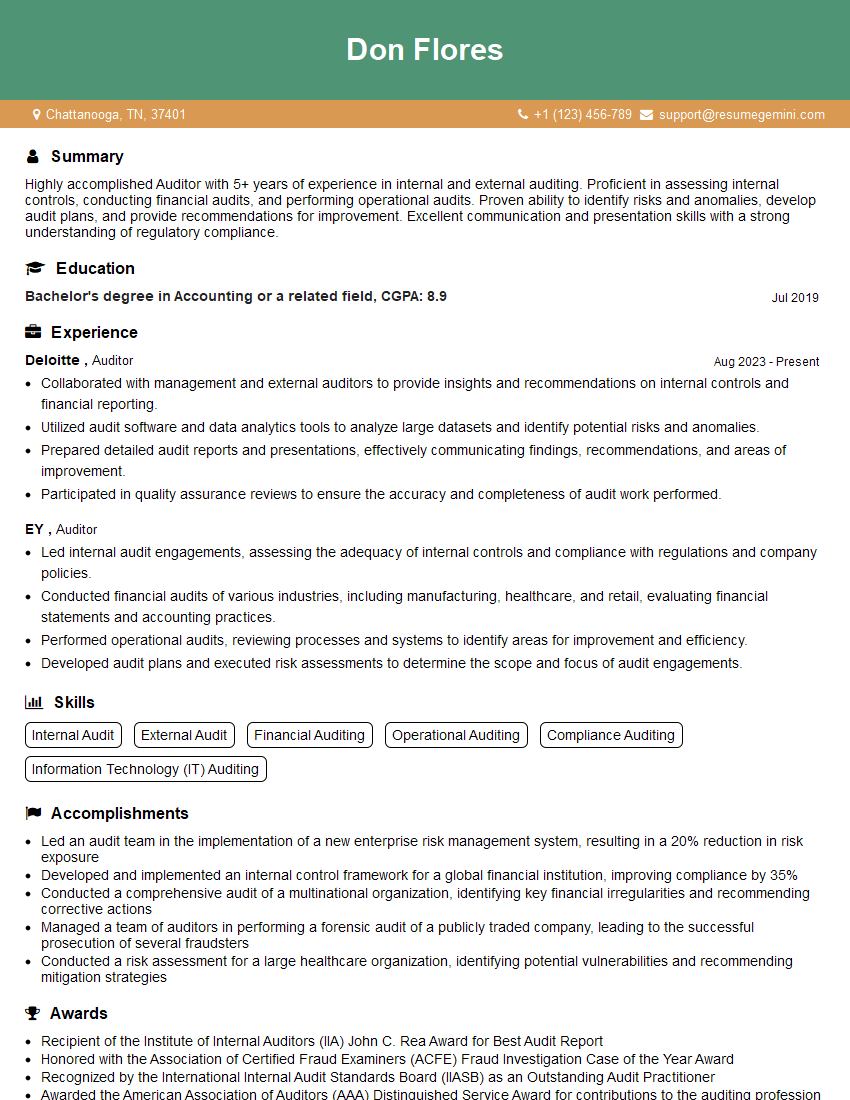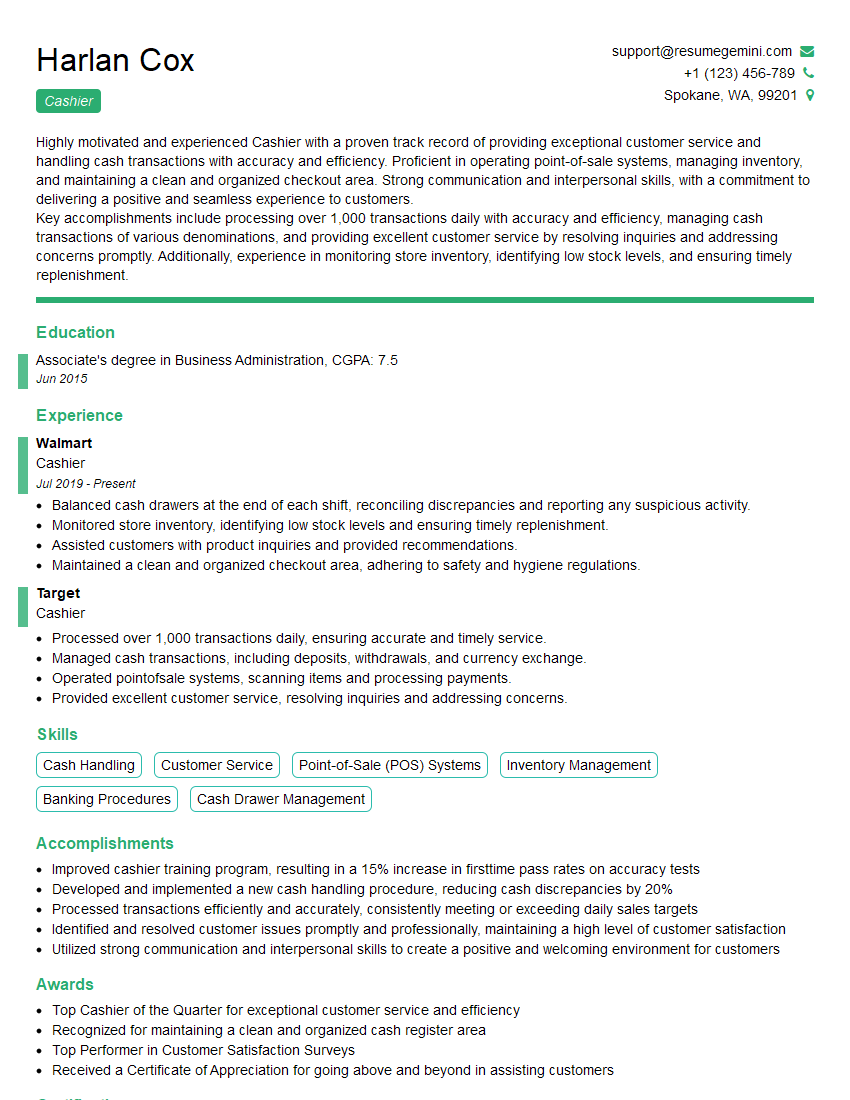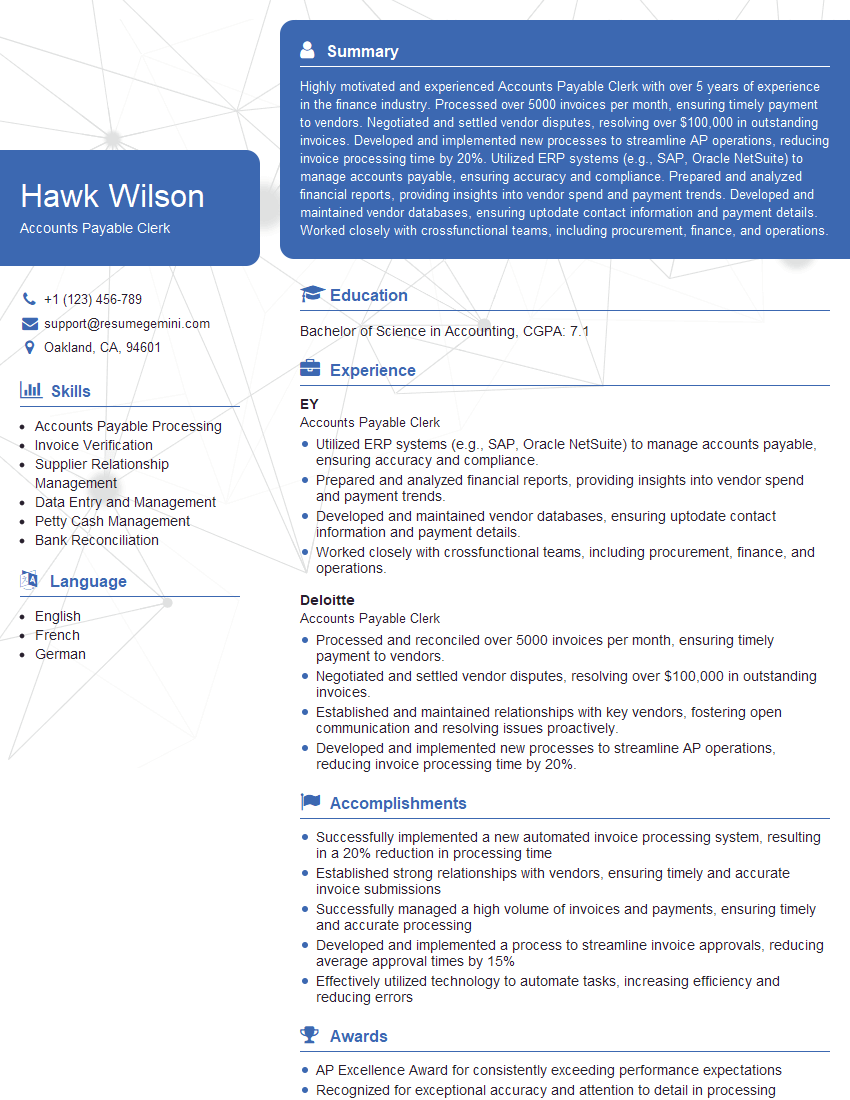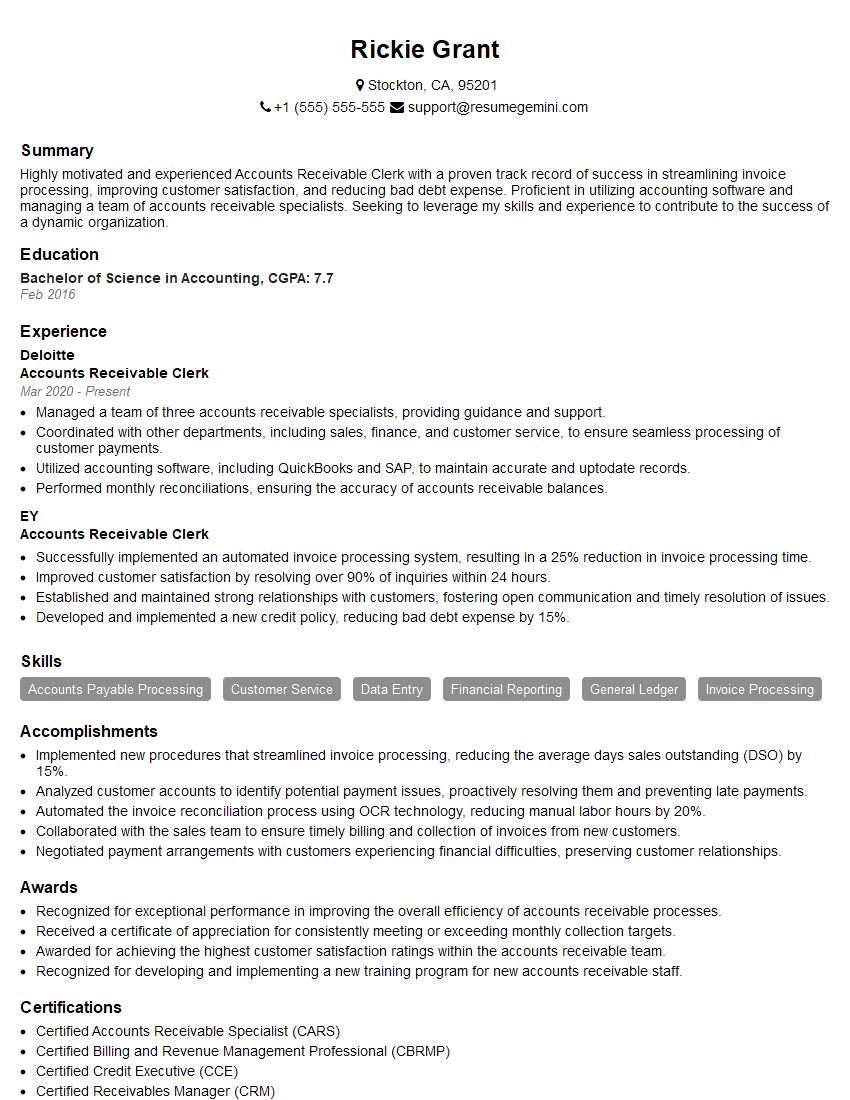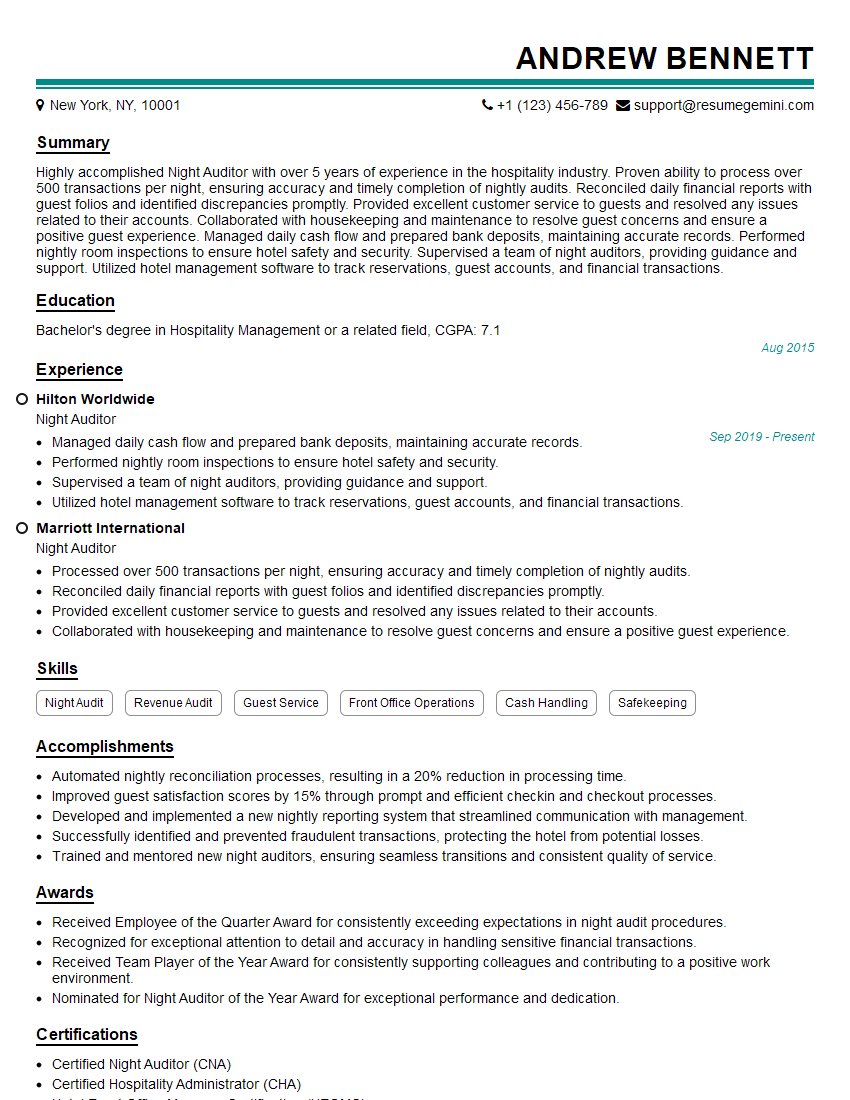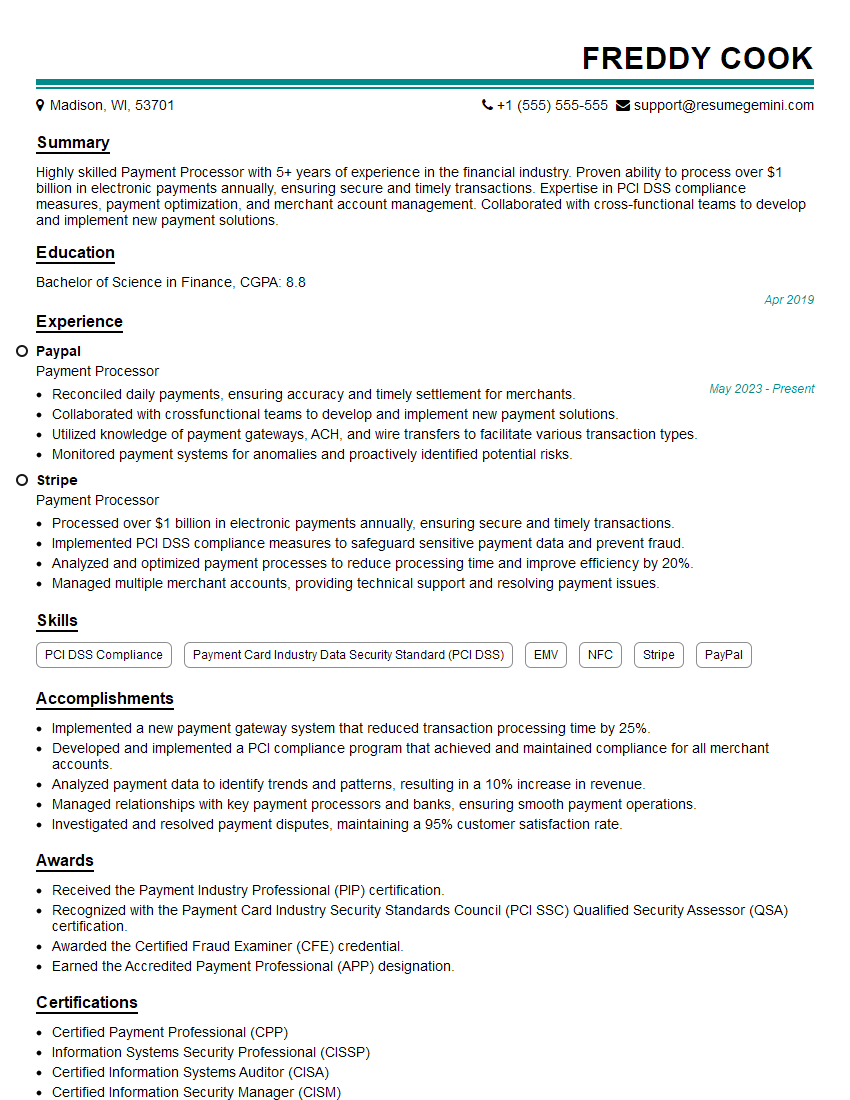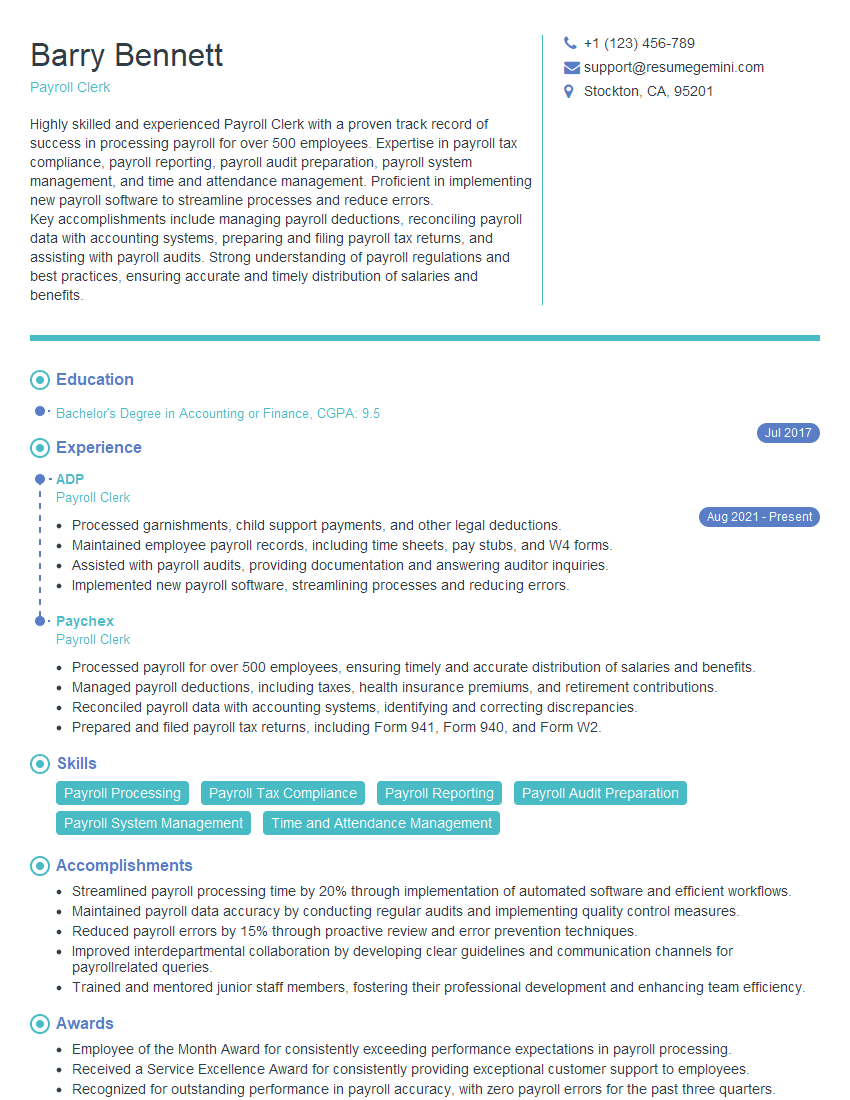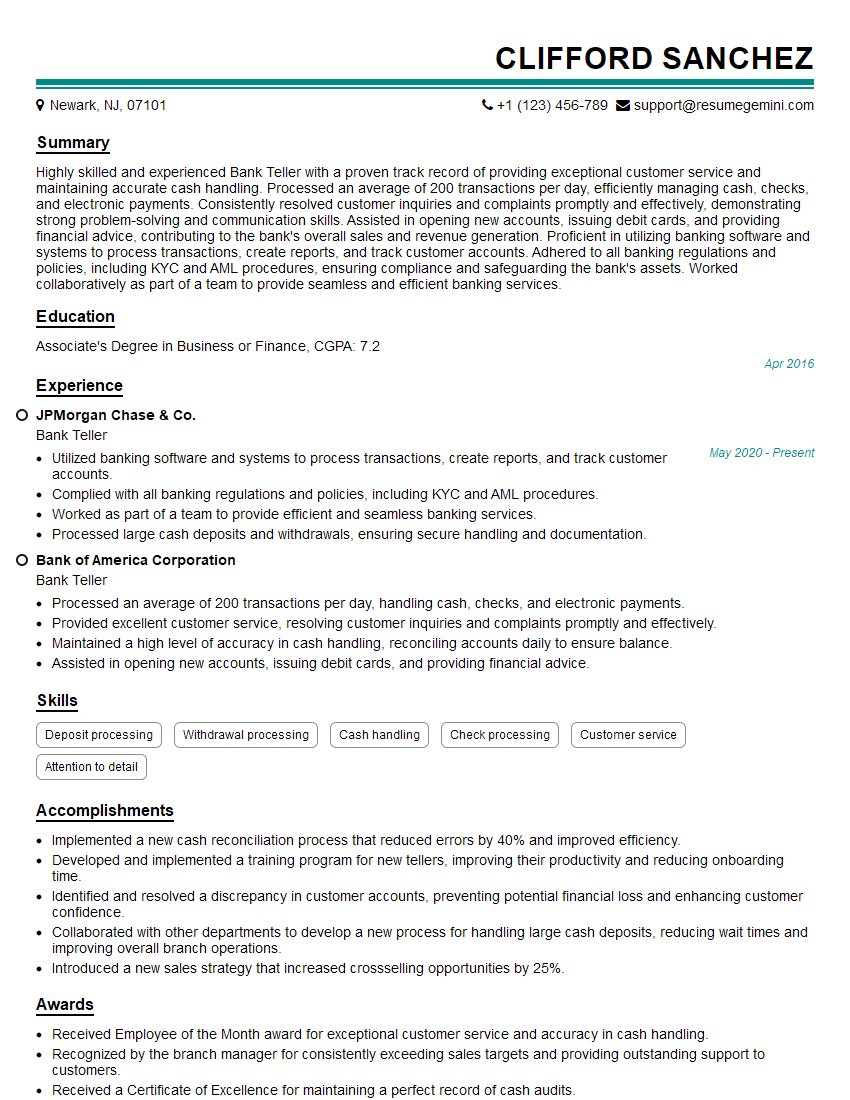Every successful interview starts with knowing what to expect. In this blog, we’ll take you through the top Handling Cash and Transactions interview questions, breaking them down with expert tips to help you deliver impactful answers. Step into your next interview fully prepared and ready to succeed.
Questions Asked in Handling Cash and Transactions Interview
Q 1. Describe your experience with handling cash transactions.
Throughout my career, I’ve extensively handled cash transactions in various settings, from high-volume retail environments to smaller, independent businesses. This experience ranges from receiving payments from customers, accurately counting and recording cash, to preparing bank deposits and managing petty cash funds. For instance, in my previous role at a busy coffee shop, I processed hundreds of cash transactions daily, ensuring each transaction was accurate and efficiently handled. This involved handling bills and coins of various denominations, making change accurately, and managing the cash drawer to minimize discrepancies.
Q 2. What methods do you use to ensure accurate cash handling?
Accurate cash handling is paramount. My methods involve a multi-step process: First, I meticulously count cash received from each customer, verifying the amount against the purchase. Second, I use a cash register or point-of-sale (POS) system to record each transaction, providing a digital audit trail. Third, I frequently reconcile the cash drawer throughout the shift to identify and correct any discrepancies early on. This involves comparing the cash on hand to the recorded transactions in the register. Finally, I implement a system of double-checking cash counts, often with a colleague, to minimize human error. Think of it like a quality control process, each step verifying the accuracy of the previous one.
Q 3. How do you reconcile cash drawers at the end of a shift?
Reconciling the cash drawer at the end of a shift is a crucial step in maintaining financial accuracy. I follow a detailed procedure: 1. I count all the cash in the drawer, separating bills and coins by denomination. 2. I then total the cash count. 3. I generate a Z-report (or equivalent report from the POS system) which shows the total sales, payments, and cash drawer start amount. 4. I compare the physical cash count to the net cash amount displayed on the Z-report. Any discrepancy requires immediate investigation. 5. Once the reconciliation is complete and any errors are addressed, I prepare the cash for deposit, properly securing and documenting it.
Q 4. Explain your experience with different payment processing systems (e.g., credit cards, debit cards, mobile payments).
I’m proficient in various payment processing systems. My experience includes handling credit and debit cards through POS terminals, processing mobile payments via platforms like Apple Pay and Google Pay, and even handling alternative payment methods like gift cards and checks. In a previous role, I was trained on the specific security protocols and compliance regulations for each payment type, ensuring secure and compliant processing. Understanding different systems enables efficient and smooth customer transactions, and it also helps with accurate financial reporting.
Q 5. How do you handle discrepancies in cash counts?
Discrepancies in cash counts require careful investigation. The first step is to retrace the steps of the shift, reviewing transactions and comparing them to the cash drawer. I’ll often recount the cash in the drawer multiple times to rule out simple counting errors. If the discrepancy persists, I thoroughly check the Z-report and POS logs for any unusual transactions or missing data. If I can’t resolve it independently, I escalate the issue to my supervisor for review and potential further investigation. Documentation of the discrepancy and resolution process is essential.
Q 6. What are some common errors in cash handling, and how do you prevent them?
Common cash handling errors include simple counting mistakes, inaccurate change given, and errors in recording transactions. To prevent these, I emphasize careful counting, double-checking transactions, and utilizing POS systems to minimize human error. Regular training on cash handling procedures, along with the use of cash handling tools like cash counters, significantly reduces errors. Furthermore, maintaining a clean and organized work environment facilitates accuracy. Think of it like a surgeon’s precision – careful attention to detail minimizes the risk of mistakes.
Q 7. How do you balance a cash register?
Balancing a cash register is synonymous with reconciling the cash drawer. It involves comparing the physical cash count against the register’s record of sales and payments. The process involves: 1. Counting the cash in the drawer. 2. Generating a Z-report (or similar report) from the register, summarizing all transactions. 3. Comparing the total cash on hand to the net cash from the Z-report. The amounts should match. Any discrepancy needs to be investigated and resolved before closing the register. It’s like solving a simple accounting equation – the starting cash plus sales minus expenses should equal the ending cash.
Q 8. Describe your experience with cash deposit procedures.
Cash deposit procedures are crucial for maintaining accurate financial records and ensuring security. My experience encompasses various methods, from manual counting and recording to utilizing automated deposit machines and integrated POS systems. A typical procedure involves verifying the cash amount against the deposit slip, ensuring accuracy. This is followed by securely packaging the cash, often in tamper-evident bags, and completing the necessary paperwork. Finally, the deposit is made either through a bank teller, ATM, or armored vehicle service, depending on the volume and security requirements. For instance, at my previous role, we processed daily deposits averaging $15,000, employing a dual-control system where two employees verified the count and documentation before sealing the deposit. This ensured accountability and minimized the risk of error or theft.
Q 9. How do you manage large sums of cash?
Managing large sums of cash demands stringent security protocols and efficient processes. My approach involves a layered security system: first, minimizing cash exposure by utilizing electronic payment options whenever possible. For larger cash transactions, we utilize armored car services for transport and secure, high-security safes for storage, often with multiple locks and access restrictions. Regular audits are crucial, conducted by independent parties to ensure accuracy and compliance. Detailed logging of all cash transactions, including date, time, amount, and individuals involved, is paramount. Think of it like running a high-stakes vault – every detail must be meticulously recorded and double-checked. For example, in a previous position, we handled weekly cash receipts exceeding $100,000, implementing a three-person verification system for every transaction.
Q 10. What security measures do you implement when handling cash?
Security is paramount when handling cash. My experience includes implementing several measures such as:
- Surveillance systems: CCTV cameras covering all cash handling areas.
- Access control: Restricted access to cash handling areas, using keycard systems or biometric authentication.
- Dual control: Requiring two individuals to be present for all cash transactions above a certain threshold.
- Secure storage: Utilizing high-security safes and vaults with tamper-evident seals.
- Regular audits: Conducting internal and external audits to detect discrepancies and ensure compliance.
- Employee training: Regular training for staff on cash handling procedures, security protocols, and fraud prevention.
Q 11. How do you handle customer disputes regarding cash transactions?
Customer disputes regarding cash transactions require a calm, professional approach. My process involves:
- Gathering information: Carefully listening to the customer’s complaint, obtaining details of the transaction (date, time, amount, any supporting evidence).
- Reviewing records: Checking internal records—POS data, security footage, and employee logs—to corroborate the customer’s account.
- Reconciling discrepancies: Attempting to resolve the discrepancy by comparing different sources of information. This might involve reviewing the customer’s bank statement or other relevant documentation.
- Mediation and resolution: Offering a fair solution, which may involve a refund, store credit, or an explanation of the discrepancy. Documentation of the entire process is essential.
- Escalation: If a resolution cannot be reached, escalating the issue to a manager or supervisor.
Q 12. Describe your experience with handling returns and refunds.
Handling returns and refunds requires a clear and consistent procedure to ensure accuracy and prevent fraud. My experience includes processing returns and issuing refunds for various reasons, including damaged goods, incorrect orders, and customer dissatisfaction. This typically involves verifying the purchase, inspecting the returned merchandise, issuing a refund via the original payment method (cash, credit, debit), and updating inventory records. In the case of cash refunds, we often require proof of purchase and verification against the original transaction records. Detailed logging and documentation are crucial for tracking returns and preventing potential losses. For example, using a specific return form with unique ID numbers allows easy tracking and verification. Implementing a clear return policy, readily available to customers, minimizes potential conflicts and ensures efficiency.
Q 13. What is your experience with POS systems?
My experience with POS (Point of Sale) systems is extensive. I’m proficient in using various POS software and hardware for processing transactions, managing inventory, generating reports, and handling customer loyalty programs. I understand how to configure and troubleshoot these systems, ensuring smooth and accurate transaction processing. I’m familiar with features such as barcode scanning, electronic payments (credit/debit cards, contactless payments), cash drawer management, and reporting functionalities. For example, in my last role we utilized Square POS, and I was responsible for daily reconciliation, resolving transaction errors, and generating sales reports for financial analysis. The proficiency in POS systems directly contributes to efficiency and reduces errors in daily operations.
Q 14. How do you deal with counterfeit money?
Counterfeit money is a serious concern that requires immediate action. My experience includes using both visual inspection techniques and counterfeit detection pens to identify suspicious bills. Once a potentially counterfeit bill is detected, it’s immediately removed from circulation and secured in a tamper-evident bag. Local law enforcement is notified, and all relevant information about the transaction is documented and preserved. Employee training is crucial to increase awareness and the ability to identify suspicious notes. We employ a comprehensive training program which incorporates both theoretical knowledge and hands-on practice with various types of counterfeit bills. Moreover, regular updates on new counterfeit techniques are shared within the team to maintain vigilance. Preventing the circulation of counterfeit currency requires diligence and a well-defined procedure.
Q 15. What are the common regulations related to cash handling in your region?
Cash handling regulations vary by region, but common themes include anti-money laundering (AML) laws, tax regulations, and record-keeping requirements. In many jurisdictions, businesses are required to report cash transactions exceeding a certain threshold to the relevant authorities. These thresholds and reporting methods differ. For example, in the US, businesses must report cash transactions exceeding $10,000 using Form 8300. Similarly, strict record-keeping practices are mandated, often involving detailed logs of all cash transactions, including the date, time, amount, and description of each transaction. Failure to comply with these regulations can result in significant penalties, including fines and legal repercussions. Additionally, regulations often address physical security measures for cash storage, including the use of safes, security cameras, and alarm systems.
Specific regional variations necessitate staying updated on the latest legal and regulatory developments. This often involves consulting with legal and financial professionals to ensure full compliance.
Career Expert Tips:
- Ace those interviews! Prepare effectively by reviewing the Top 50 Most Common Interview Questions on ResumeGemini.
- Navigate your job search with confidence! Explore a wide range of Career Tips on ResumeGemini. Learn about common challenges and recommendations to overcome them.
- Craft the perfect resume! Master the Art of Resume Writing with ResumeGemini’s guide. Showcase your unique qualifications and achievements effectively.
- Don’t miss out on holiday savings! Build your dream resume with ResumeGemini’s ATS optimized templates.
Q 16. How do you maintain accurate records of cash transactions?
Maintaining accurate cash transaction records is crucial for financial health and regulatory compliance. I utilize a multi-layered approach. First, every cash transaction is recorded in real-time using a point-of-sale (POS) system or cash register. This system generates detailed reports showing daily sales, refunds, and any discrepancies. Secondly, all cash is counted and reconciled at the end of each shift or day. This involves comparing the physical cash count with the POS system’s total. Any differences are investigated immediately. Finally, regular internal audits are performed to verify the accuracy of the records. This audit trail, combining POS data, physical cash counts, and internal audit reports, provides a robust system for tracking cash transactions.
Think of it like balancing a checkbook – it’s not just about recording deposits and withdrawals, but also regularly verifying that the balance shown in your records matches the actual balance in your account. Inconsistencies highlight the need for investigation and corrective action.
Q 17. How do you ensure the safety and security of cash in your workplace?
Cash security is paramount. We employ a layered security approach incorporating physical security and procedural controls. Physical security includes using secure cash registers with anti-theft features, storing cash in a fire-resistant safe, and utilizing security cameras to monitor activity. Procedural controls include limiting access to cash handling areas, implementing strict cash handling protocols (e.g., two-person control for large sums), and regularly rotating staff responsibilities to prevent complacency. We also conduct regular security audits to identify and address any vulnerabilities.
For example, we might use time-delay safes to deter robbery, or implement a system where only authorized personnel can access the safe’s combination.
Q 18. How do you handle a situation where a cash register malfunctions?
If a cash register malfunctions, the first step is to secure the cash and immediately switch to a backup system, if available. This ensures continued business operation and prevents loss of sales. We then document the malfunction thoroughly, noting the time, nature of the malfunction, and any potential data loss. We might use a manual record of transactions until the register is repaired. Next, I’d contact technical support to address the issue and schedule repairs or replacement. Finally, once the register is operational again, we would reconcile the manual transactions with the electronic records to ensure accuracy. It’s crucial to prioritize data integrity and customer service during this process.
Think of it like a traffic detour – a road closure requires finding an alternative route to ensure the journey continues smoothly. We aim for a seamless transition, minimizing disruption to both customers and operations.
Q 19. What is your experience with different currencies?
My experience encompasses handling various currencies, including USD, EUR, GBP, and CAD. This involves understanding the exchange rates, identifying counterfeit notes, and ensuring accurate conversions. I am proficient in using currency conversion tools and maintaining up-to-date exchange rate information. In addition to the technical aspects of handling different currencies, I’m aware of the cultural nuances associated with cash transactions in diverse settings. For example, the preferred methods of payment and tipping customs can significantly differ across cultures, impacting how cash transactions are handled.
This experience helps ensure smooth and efficient transactions regardless of the currency involved. For example, knowledge of counterfeit detection methods for different currencies reduces the risk of financial loss.
Q 20. Explain your understanding of internal controls related to cash handling.
Internal controls related to cash handling aim to prevent fraud, theft, and errors. Key elements include segregation of duties (different individuals responsible for handling cash, recording transactions, and reconciling accounts), authorization procedures (approvals for large cash withdrawals or payments), regular reconciliation of cash balances, and physical security measures to protect cash. Detailed documentation, including audit trails, is crucial. Internal controls are regularly reviewed and updated to adapt to changing risks and regulatory requirements.
A strong system of internal controls acts as a safeguard, like multiple locks on a door, making it more difficult for unauthorized access or errors to occur.
Q 21. Describe a time you had to deal with a significant cash shortage or overage. How did you resolve it?
In a previous role, we discovered a significant cash shortage at the end of a busy day. We immediately initiated an investigation, reviewing security camera footage, POS system data, and employee timecards. After a thorough review, we found a discrepancy in the cash register tape and a minor counting error. The issue stemmed from a new employee’s lack of experience with proper cash handling procedures. We addressed the situation by providing additional training to the employee, reinforcing procedures, and improving our internal controls, including implementing more frequent cash counts throughout the day. This also led to improvements in our reconciliation process and a more detailed review of register tapes. The shortage was ultimately recovered through adjusting the employee’s pay. This experience highlighted the importance of training, proactive oversight, and robust internal controls to prevent similar incidents.
It was a challenging situation, but it taught me the value of thorough investigation, clear communication, and a commitment to continuous improvement in our processes.
Q 22. What software or tools are you proficient in using for cash handling and transaction processing?
My proficiency in cash handling and transaction processing extends to several software and tools. I’m highly experienced with POS (Point-of-Sale) systems like Square, Clover, and Lightspeed, which are widely used in retail and hospitality settings. These systems allow for efficient transaction recording, inventory management, and reporting. I’m also comfortable using specialized cash management software like those offered by many banks for reconciliation and fraud prevention. Beyond specific software, I’m adept at using spreadsheets like Microsoft Excel and Google Sheets for detailed financial analysis, reconciliation, and reporting. Finally, I’m proficient with secure payment gateways like Stripe and PayPal, ensuring safe and efficient online transactions.
- Example: In my previous role, I used Clover to manage daily sales, track inventory levels, and generate detailed reports for tax purposes. The system’s reporting features allowed us to identify our best-selling products and optimize inventory.
- Example: I’ve used Excel extensively to reconcile bank statements, ensuring accuracy and identifying any discrepancies between physical cash counts and digital records.
Q 23. How do you prioritize tasks when dealing with a high volume of cash transactions?
Prioritizing tasks during high-volume cash transactions requires a structured approach. My strategy centers on a combination of urgency and importance. I utilize a system similar to the Eisenhower Matrix (Urgent/Important), allowing me to focus on time-sensitive tasks that directly impact financial accuracy and customer satisfaction.
- High Urgency, High Importance: Balancing the cash drawer at the end of the day, processing urgent refunds, and addressing immediate customer payment issues take top priority. Think of this like putting out fires – immediate action is crucial.
- High Importance, Low Urgency: Reconciling daily transactions against the POS system, preparing bank deposits, and conducting regular inventory counts are important but don’t necessarily require immediate attention. This is more like preventative maintenance.
- High Urgency, Low Importance: Answering less critical customer inquiries or dealing with minor discrepancies can sometimes wait, particularly when critical tasks demand immediate attention.
- Low Urgency, Low Importance: Tasks like cleaning the workspace or performing routine system updates can be scheduled for less busy periods.
This structured approach prevents bottlenecks and ensures the most critical tasks receive prompt attention.
Q 24. Explain your experience with using a cash register or point-of-sale system.
My experience with cash registers and POS systems spans several years and various environments, from small independent shops to larger retail chains. I’m proficient in operating diverse systems, from basic cash registers to sophisticated touch-screen POS systems with integrated payment processing capabilities. My skills include:
- Transaction Processing: Efficiently processing various payment types (cash, credit/debit cards, gift cards, mobile payments).
- Customer Service: Providing friendly and accurate service while handling transactions quickly and efficiently.
- Inventory Management: Using POS systems to track inventory levels, identify low stock items, and generate reports to aid in ordering.
- Troubleshooting: Identifying and resolving minor technical issues with POS hardware or software.
- Data Entry: Accurately recording transactions and handling returns and exchanges.
Example: In a previous role at a busy cafe, I used a POS system to manage orders, process payments, and track sales data in real-time. I was responsible for daily reconciliation and ensured the accuracy of all financial records.
Q 25. What steps do you take to verify the accuracy of a customer’s payment?
Verifying the accuracy of a customer’s payment is crucial to prevent errors and fraud. My approach involves several steps:
- Confirm the Payment Amount: I clearly state the total amount due to the customer and visually confirm it matches their payment.
- Verify Payment Method: I check if the payment method (cash, card, etc.) is valid and functioning correctly. For card payments, I ensure the card is not expired and the transaction is authorized.
- Count Cash Accurately: When receiving cash, I count the money twice—once in front of the customer and again privately to avoid discrepancies.
- Check for Counterfeit Bills: I’m trained to identify counterfeit currency and use verification tools (pen test, UV light) when necessary.
- Record the Transaction: I ensure the transaction is accurately recorded in the POS system, noting the payment type and amount.
- Issue a Receipt: I provide the customer with a receipt detailing the purchase and payment details.
Example: If a customer pays with a credit card, I check the signature on the back against the signature captured on the POS terminal. I then verify the transaction authorization on the terminal itself before handing the customer their receipt.
Q 26. How do you maintain confidentiality when handling sensitive financial information?
Maintaining confidentiality when handling sensitive financial information is paramount. I adhere to strict protocols to safeguard customer data and prevent unauthorized access. These include:
- Data Security: Never leaving financial documents unattended, shredding sensitive paperwork appropriately.
- Password Protection: Using strong passwords for all POS systems and online payment portals. Never sharing passwords with others.
- Secure Storage: Following company procedures for securing cash and financial records, whether in a safe, vault, or secured digital system.
- Data Minimization: Only accessing the necessary financial information required to complete transactions.
- Compliance: Adhering to all relevant data protection regulations and company policies.
Example: If I find a discarded credit card slip, I immediately secure it and report it to my supervisor in accordance with the company’s lost and found policies.
Q 27. What is your understanding of anti-money laundering (AML) regulations?
My understanding of Anti-Money Laundering (AML) regulations is comprehensive. AML regulations are designed to prevent criminals from using financial systems to launder illegally obtained funds. This involves identifying and reporting suspicious activity to the relevant authorities. My knowledge includes:
- Know Your Customer (KYC): Understanding the importance of verifying the identity of customers to prevent the use of false identities for money laundering.
- Suspicious Activity Reporting (SAR): Knowing the procedures for reporting any suspicious transactions or activities that may indicate money laundering.
- Due Diligence: Understanding the importance of conducting thorough due diligence on customers and transactions to mitigate risks.
- Record Keeping: Maintaining accurate and complete records of all transactions to facilitate audits and investigations.
Example: If I notice a large cash transaction exceeding a certain threshold that seems inconsistent with the customer’s known business, I would report it to my manager who would then follow the proper procedures to file a SAR report.
Q 28. How do you adapt to changes in cash handling procedures or technology?
Adapting to changes in cash handling procedures or technology is crucial in this field. My approach involves proactive learning and a willingness to embrace new systems and methodologies. This includes:
- Continuous Learning: Staying updated on industry best practices, new technologies (e.g., contactless payments), and updated regulations. This might involve attending workshops, webinars, or reading industry publications.
- Openness to Change: Embracing new technologies and adapting quickly to new procedures. I view change as an opportunity for growth and efficiency.
- Seeking Feedback: Regularly seeking feedback on my performance and actively participating in training programs.
- Problem-Solving: Approaching new challenges with a positive attitude, seeking solutions, and collaborating with colleagues.
Example: When our company implemented a new POS system, I actively participated in the training program, seeking clarification on any aspects that were unclear. I then used my initiative to familiarize myself with the system’s functionalities.
Key Topics to Learn for Handling Cash and Transactions Interview
- Cash Handling Procedures: Understanding proper cash handling techniques, including receiving, counting, balancing, and securing cash. This includes knowledge of different cash handling equipment and security protocols.
- Point of Sale (POS) Systems: Familiarity with various POS systems, their functionalities (e.g., processing payments, issuing receipts, managing inventory), and troubleshooting common issues. Practical experience with specific POS systems is highly valuable.
- Transaction Processing: Mastering the entire transaction lifecycle, from customer interaction to final reconciliation. This encompasses understanding different payment methods (cash, credit/debit cards, mobile payments), processing returns and refunds, and managing discrepancies.
- Reconciliation and Reporting: Accurately reconciling daily cash transactions, identifying and resolving discrepancies, and generating accurate reports for management. Understanding key financial metrics related to cash handling is essential.
- Fraud Prevention and Security: Implementing measures to prevent cash theft and fraud, adhering to company policies and procedures, and identifying suspicious activities. This includes understanding best practices for securing cash and preventing errors.
- Customer Service in Transactions: Providing excellent customer service during transactions, handling customer inquiries and complaints efficiently and professionally, and ensuring a positive customer experience.
- Regulatory Compliance: Understanding relevant regulations and laws pertaining to cash handling and financial transactions (e.g., tax laws, anti-money laundering regulations).
Next Steps
Mastering cash handling and transactions is crucial for career advancement in numerous fields, opening doors to roles with increased responsibility and earning potential. A well-crafted resume is your key to unlocking these opportunities. An ATS-friendly resume, optimized for applicant tracking systems, ensures your qualifications are seen by hiring managers. To significantly enhance your resume and increase your chances of landing your dream job, leverage the power of ResumeGemini. ResumeGemini provides you with the tools and resources to build a professional and impactful resume. Examples of resumes tailored to Handling Cash and Transactions are available to help guide you.
Explore more articles
Users Rating of Our Blogs
Share Your Experience
We value your feedback! Please rate our content and share your thoughts (optional).
What Readers Say About Our Blog
Hi, I’m Jay, we have a few potential clients that are interested in your services, thought you might be a good fit. I’d love to talk about the details, when do you have time to talk?
Best,
Jay
Founder | CEO

